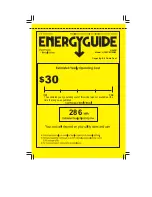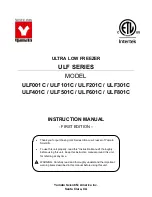
A -2
Isotemp ULT Chest
Fisher Scientific
Appendix A
Handling Liquid Nitrogen
The safe handling and use of liquid nitrogen in cryogenic refrigerators and
dewar flasks is largely a matter of knowing the potential hazards and using
common-sense procedures based on that knowledge. There are two
important properties of liquid nitrogen that present potential hazards:
1. It is extremely cold. At atmospheric pressure, liquid nitrogen boils at
-320°F (-196°C).
2. Very small amounts of liquid vaporize into large amounts of gas. One
liter of liquid nitrogen becomes 24.6 cu. ft. (700l) of gas.
The safety precautions in this booklet must be followed to avoid potential
injury or damage which could result from these two characteristics. Do
not attempt to handle liquid nitrogen until you read and fully understand
the potential hazards, their consequences, and the related safety
precautions. Keep this booklet handy for ready reference and review.
Note
Because argon is an inert gas whose physical properties are very
similar to those of nitrogen, precautions and safe practices for the handling
and use of liquid argon are the same as those for liquid nitrogen.
s
Use only containers designed for low temperature liquids.
Cryogenic containers are specifically designed and made of materials that
can withstand the rapid changes and extreme temperature differences
encountered in working with liquid nitrogen. Even these special
containers should be filled SLOWLY to minimize the internal stresses that
occur when any material is cooled. Excessive internal stresses can damage
the container.
Do not cover or plug the entrance opening of any liquid nitrogen
refrigerator or dewar. Do not use any stopper or other device that would
interfere with venting of gas.
These cryogenic liquid containers are generally designed to operate with
little or no internal pressure. Inadequate venting can result in excessive gas
pressure which could damage or burst the container. Use only the loose-
fitting necktube core supplied or one of the approved accessories for
closing the necktube. Check the unit periodically to be sure that venting
is not restricted by accumulated ice or frost.
Introduction
Summary of Contents for I903C
Page 5: ......
Page 37: ......
Page 49: ......
Page 55: ......
Page 56: ...Fisher Scientific 2000 Park Lane Drive Pittsburgh PA 15275 USA www thermofisher com...






































